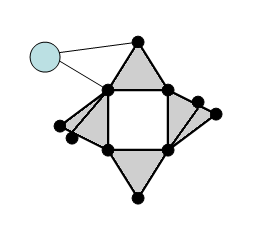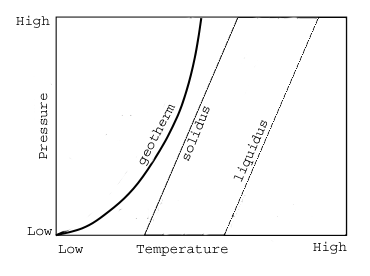For oxygen to have full shells, it would need to accept 2 electrons from some other atom(s) and become an anion with a -2 charge.
Friday 4/2
1) How are body waves different
from sufrace waves? For body waves, the disturbance of the Earth
can travel through the interior of the Earth. For surface waves,
the disturbance of the Earth travels along the surface, and rapidly dies
down with depth. That is a fancy way of saying that body waves can
travel through the Earth's interior, and surface waves cannot--they only
travel along the Earth's surface.
2) Explain how the motion
of a P wave is different from an S wave. The direction that the ground
vibrates back and forth is the same direction that the wave travels for
a P wave (a P wave is compressional and the ground compresses and extends
in the direction that the wave travels). For an S wave, the direction
that the ground vibrates (which is kind of an up and down motion) is perpendicular
(at right angles) to the direction that the wave travels.
3) How do we find the distance
to the epicenter of an EQ using a seismogram? By knowing the velocities
of P and S waves and by seeing what the arrival time difference is between
those two waves at our recording station (we assume both P and S waves
left the epicenter at the same time). An analogy. If I told
you that two automobiles left some town (called Epicenter) at the same
time, one going 60 mph (and called the P car) and one going 30 mph (and
called the S car), and that the P car arrived at your house one hour before
the S car, you would be able to figure out how far away the town of Epicenter
is from your house. Think about it. Suppose you guess that Epicenter
is 30 miles away. That would mean that car P would arrive 1/2 hour
after it left and car S would arrive 1 hour after it left. So the
two cars would arrive at your house 1/2 hour apart--but that isn't what
you saw. So how about 60 miles away. Car P would arrive 1 hour
after it left and car S 2 hours after it left. You would see car
S arrive 1 hour after car P--hey, that's correct. A complicating
factor is that P wave and S wave velocities aren't constant, but depend
on the properties of the materials they pass through Someone has already
done the calculations for us, and given us travel-time curves. But
it works the same way - we look at the difference in the arrival times
and use the curve to figure out how far away we are.
Monday 4/5
1) For the first question,
you know that oxygen has 8 protons. That means for an electrically
neutral oxygen atom, there should be 8 electrons. Two will be in
the innermost shell, and six in the next shell out -- your sketch should
have looked something like the one below
For oxygen to have full
shells, it would need to accept 2 electrons from some other atom(s) and
become an anion with a -2 charge.
2) The two criteria
you need to meet to swap one atom for another in a mineral structure are
a) the size of the ion has to fit the available space in the structure
b) you have to maintain charge neutrality for the mineral (not for that
particular site--which needed to be specifically stated).
Wed 4/7

Above is a feldspar structural
unit - Na-rich plagioclase feldspar is NaAlSi3O8
1) The oxygen atoms (shown
as little black dots) are located at the corners of each tetrahedral site
(there are four corners on each tetrahedra).
2) The silicon atoms are
in the middle of the tetrahedra (surrounded by 4 oxygens). In Na-rich
plagioclase feldspar, silicon will be inside three out of every four tetrahedra
3) The aluminum atoms are
also found in the middle of a tetrahedra (surrounded by four oxygens).
In Na-rich plagioclase feldspar, aluminum will be inside one out of every
four tetrahedra
4) The sodium (Na) atoms
are located outside of the tetrahedra (indicated by the blue ball in the
diagram above).
5) This is the plagioclase
feldspar with the lowest melting temperature (the Ca-rich plagioclase feldspar
has the highest melting temperature).
Mon 4/12

1) The geotherm is a line
on the diagram below that shows you the average temperature of the mantle
at each depth (represented by pressure), so it shows you the average pressure/temperature
conditions throughought the mantle. If you don't understand this,
then you should look up web definitions until you do.
2) The geotherm is to the
left of the solidus, which means that the mantle is solid everywhere.
The geotherm gets closest to the solidus at depths (pressures) that define
the layer of the earth known as the asthenosphere.
3) The solidus is a line
separating solid mantle rock (left) from a mixture of solid and melted
mantle (right). The liquidus is a line separating a mixture of solid
and melted mantle (left) from completely melted mantle (right).
4) The two ways to melt
mantle rock are decompression melting and adding water at a subduction
zone. Decompression melting means that rock of a certain temperature
melts because the pressure is lowered, causing the rock to cross the solidus.
This can happen in a couple of ways: at a hot spot, hot rock rises
from lower depth (higher pressure) to higher depth (lower pressure) without
significant cooling. At mid-ocean ridges, the rifting thins the layers
of rock (and thus lowers the pressure on the rock beneath the mid-ocean
ridge). Adding water to the mantle changes the position of the solidus--the
line in the diagram above is for "dry" mantle.
Friday 4/23
1) We are talking about basaltic flows separately from intermediate and felsic flows because the landforms that are produced are so different. Basaltic magmas are very fluid compared to the others, rarely produce explosive volcanoes, and create a wide variety of volcanic forms (including two differently-appearing flows--pahoehoe and aa). Intermediate and felsic magmas produce a limited variety of flow features (such as domes and block flows) compared to basalt.
2) Pahoehoe is a less viscous (runnier) basalt flow than an aa flow. Pahoehoe flows develop a thin layer of elastic glassy crust, which is pulled into a rumpled or ropy texture, whereas the crust on an aa flow is thicker and breaks up into "clinkery" chunks that look like small sharp rocks covering the surface of the flow.
3) Columnar jointing is a series of long fractures that breaks a lava flow into a series of adjacent columne - it forms because solid basalt takes up less volume than basaltic magma (essentially they are cooling cracks).
4) Basaltic magma typically forms a shield volcano
Wednesday 4/28
You were asked to describe
the following (you could have made a general statement that all are produced
during pyroclastic eruptions):
ash - little shards of glass
(often curved as they are fragments that formed around a gas bubble)
scoria - also called volcanic
cinders - "frothy" rock that forms when gas-rich basaltic magma is thrown
into the air during fire-fountaining - generally dark gray/black to reddish
in color - not one of the crystalline rocks (so not a vesicular basalt)
pumice - intermediate to
felsic composition "cinders" - another "frothy" rock that looks basically
like spun glass around air bubbles - pumice floats on water
blocks - solid large chunks
of volcanic rock that were already solid before being blown off the volcano
bombs - large chunks of
solid volcanic rock that were launched as big blobs of magma from the volcano
and cooled in flight - so contain shrinkage cracks of various kinds
Wednesday 5/5
Volcanic earthquakes are
normal EQs, with P and S waves, created as rock breaks when magma passes
through it; whereas harmonic tremors are a more or less continuous vibration
of the ground associated with volcanic eruptions
Swarms are lots of volcanic
EQs happening close together - the do not always indicate a volcanic eruption
will occur and they do not always occur before a volcanic eruption
An ignimbrite is a deposti
from a pyroclastic flow
A resurgent caldera is where
a region inside a caldera begins to bulge upwards due to the emplacement
of magma beneath the caldera
Fumaroles are steam vents
and geysers are places where hot water erupts from the ground - both are
caused by the interaction of magma with groundwater
Wednesday 5/12
Tsunamis are long-wavelength waves created by a tectonic disturbance (such as EQ, landslide, volcanic eruption), that carry a great deal more energy than a normal wave (created by wind blowing over surface of water).
FALSE - The largest tsunamis are NOT generated by subduction zone EQs
hypocenter and focus are
two terms for the actual location along the fault where the rupture begins
during an EQ
epicenter is the location
on the Earth's surface directely above the hypocenter.
Wednesday 5/19
compared faults and focal spheres - answers gone over in class
Friday 5/21
A seismic discontinuity is
a boundary layer between rock with abruptly different seismic velocities
The moho is the seismic
discontinuity that marks the boundary between the crust and the mantle
The asthenosphere corresponds
to the low velocity zone
Monday 5/24
Review of earthquake hazards:
Ground shaking - building,
bridge and road collapse
Fire - resulting from falling
candles, broken gas mains, sparks from electrical wires, etc.
Landslides - in steeply
sloping areas (near mountains)
Tsunamis - particularly
associated with subduction zone EQs
Soil liquefactions - soild
loses cohesion and behaves like a liquid - otherwise "seismic proof" buildings
can collapse - can get lateral spreading and fractures.